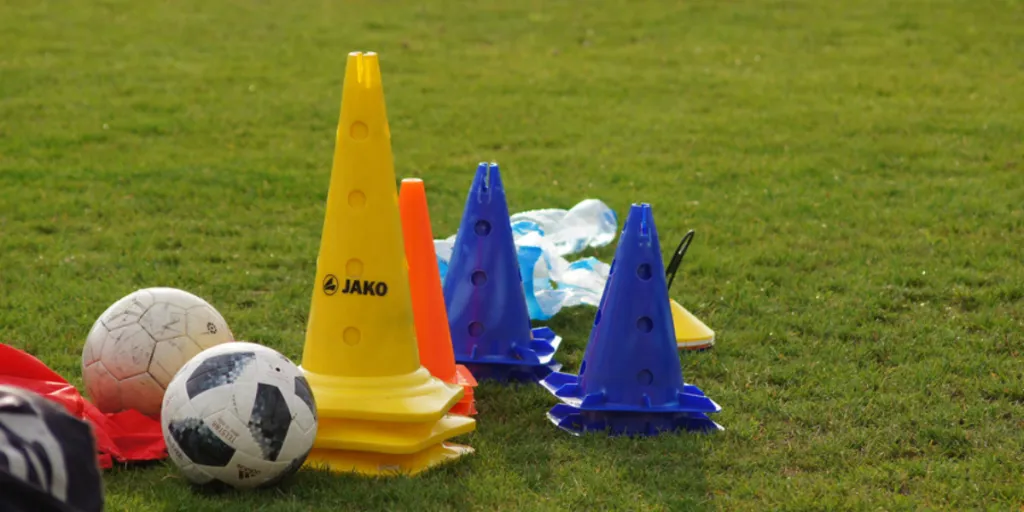Soccer is a magnificent display of skill, passion, and talent. From street soccer games to the grandest stages like the FIFA World Cup and the FIFA Women’s World Cup, the sport captivates millions of players and fans alike.
But behind the dazzling display of skill and talent, there’s something integral to any game of soccer — soccer training equipment. From basic equipment like soccer balls and shoes to advanced training equipment like fitness trackers and automatic shooting ball machines, equipment plays a pivotal role in enhancing the game.
In this article, we’ll delve into the realm of soccer training equipment, exploring industry trends, the essential items players should have in their lockers, and advanced items that can enhance performance. Let’s kick-off!
Table of Contents
Soccer training equipment: Growth trends and market forecast
Soccer training equipment checklist
Basic soccer training equipment
Extra soccer training equipment
Find a wide selection of soccer training equipment
Soccer training equipment: Growth trends and market forecast
Soccer is the world’s most popular sport, and in 2018 it’s estimated over 250 million people played the game regularly. As a result, there’s a massive demand for soccer training equipment globally.
The soccer training equipment market is expected to grow at a compound annual growth rate (CAGR) of 3.5% from 2023 to 2028, with Europe accounting for the largest market share. Meanwhile, it’s forecasted that the Asia-Pacific region will experience the fastest market growth as soccer’s popularity grows due to initiatives to popularize the sport in the region.
Soccer training equipment checklist
One doesn’t need much to play soccer. With just a soccer ball (football) and proper attire, players can enjoy the sport. However, certain players, such as professionals and players who want to enhance their skills and improve performance, require more than just the basics. So let’s explore various pieces of equipment needed to play soccer.
Basic soccer training equipment
Soccer ball
Soccer balls are undoubtedly the most essential piece of equipment required to play soccer. However, choosing an appropriate soccer ball can be pretty challenging as there are a variety of options. And if you find yourself torn between the various options, then here’s what to consider when buying a soccer ball:
Size
Soccer balls come in four sizes, each for a particular age group. Size 1 (commonly known as the mini ball) is the smallest, while size 5 is the largest.
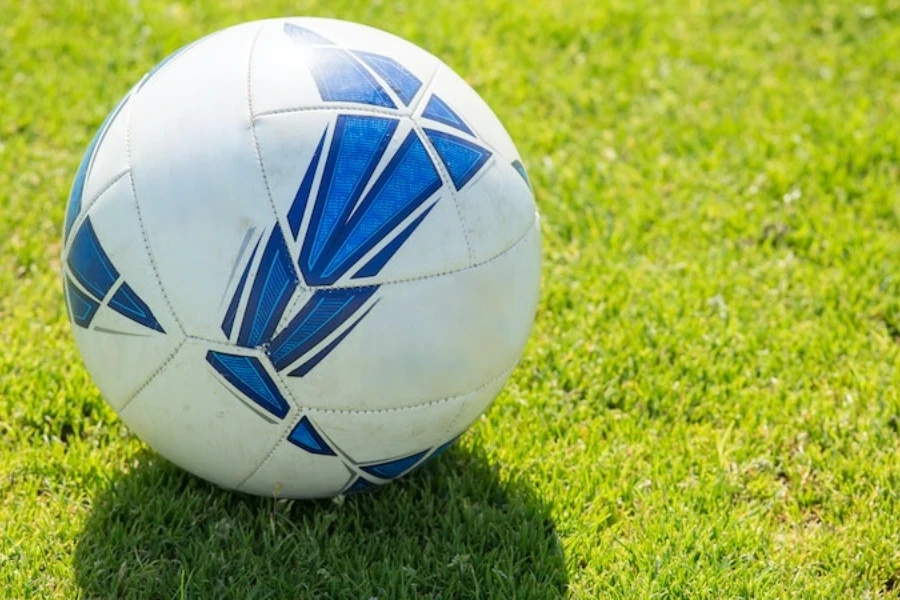
Here’s an overview of the various soccer ball sizes and how to determine the right one to purchase.
| Ball size | Ball circumference | Ages used | Other uses |
| Size 1 (Mini ball) | 18–20 in (46–51 cm) | Children under 3 | Training and skill development for professionals |
| Size 3 (Junior ball) | 23–24 in (58.5–61 cm) | 8 and below | 4 vs. 4 matches |
| Size 4 (Youth ball) | 25–26 in (63.5–66 cm) | 8 to 12 | 7 vs. 7 and 9 vs. 9 matches |
| Size 5 (Adult/pro ball) | 27–28 in (68–70 cm) | 12 and above | Official 11 vs. 11 matches |
Outer ball make-up
The outer cover of a soccer ball or casing is typically made of either PVC (polyvinyl chloride) or PU (polyurethane). Balls made of PVC casings are tough and durable. On the other hand, balls made of PU casings are softer and less durable, but they are more responsive.
As a result, professionals who want soccer balls that offer true flight prefer balls made of PU casings, while many beginners find balls made of PVC sufficient for their needs.
Bladder material
The bladder is the air component at the center of a soccer ball that gives it its shape and bounce. Soccer balls primarily consist of one of two bladder materials: butyl or latex.
Balls with butyl bladders don’t require regular inflation because they retain air well. On the other hand, balls with latex bladders need to be inflated at least once weekly because they lose air faster. However, despite this downside, many professionals prefer balls made with latex bladders because they’re more responsive and offer better flight.
League standard
Soccer balls used in official matches must adhere to specific standards. While soccer ball standards vary from one league to another, there are primarily two governing bodies that determine ball standards: FIFA (Fédération Internationale de Football Association) and The International Football Association Board (IFAB). Check the ball standards specified by these bodies to determine the right soccer ball for your customers.
Soccer shoes
After soccer balls, soccer shoes or cleats are another essential piece of equipment players require to enjoy the game.’ Soccer shoes are tailor-made for the unique needs of soccer players.
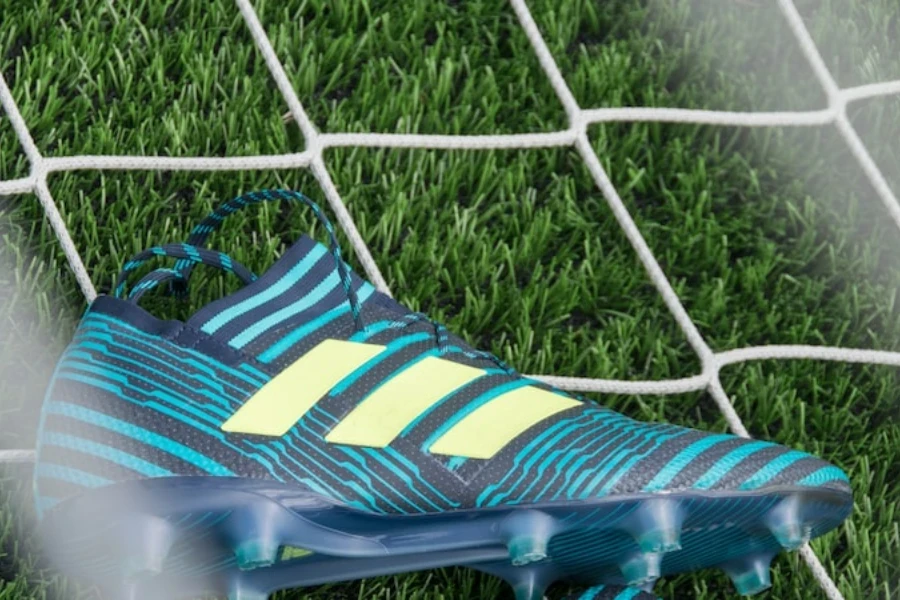
Unlike other athletic shoes, soccer shoes provide players with the optimal traction to jump, shoot, pass, and dribble easily. They also feature studs and molded bottoms that distribute weight evenly and protect players from injuries.
Check out our ultimate guide to buying soccer shoes to learn everything you need to know about choosing the right ones.
Shin guards
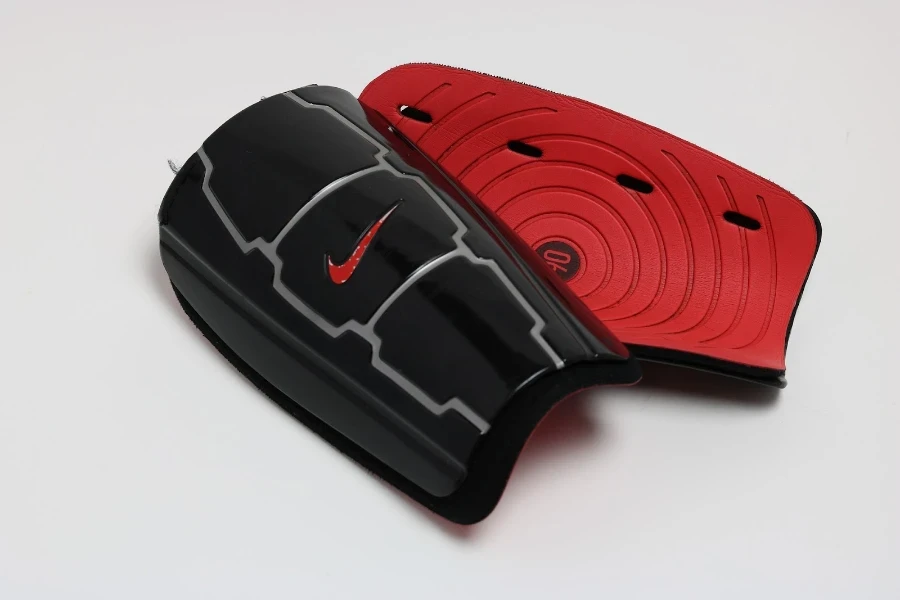
Since soccer is a contact sport, players are vulnerable to injuries — particularly on the shin. That’s where shin guards or shin pads come in. Shin guards are worn at the front of the shin beneath soccer socks to protect players from impact injuries to the shin.
Here are some key factors to consider when buying shin guards:
Size
Shin guards come in different sizes based on age ranges or height. Here’s how to determine the right shin guard size to purchase:
- Small: Fits players up to 5 ft tall (152.40 cm)
- Medium: Fits players up to 5ft 10 in (177.80 cm)
- Large: Fits players up to 6ft 4 in (193.04 cm)
- Extra large: Fits players up to 6 ft 10 in (208.28 cm)
However, these are general recommendations. If provided, check the manufacturer’s shin guard sizing chart to identify the right fit. Generally, while many sizing charts provide age ranges, height is the most crucial factor to consider when choosing an appropriate size.
Type
Shin guards come in two variants: slip-in-style and strapped-on-style shin guards. Slip-in shin guards are the most common, and they feature a compression sleeve that players insert into their socks. The compression sleeve keeps the shin guard in place.
Slip-in shin guards are incredibly lightweight and comfortable and offer greater mobility. However, they don’t provide ankle protection. Because of these qualities, they are typically worn by older or professional players.
On the other hand, strapped-on shin guards feature Velcro straps that wrap around the leg to keep the shin guard in place. Some variants also feature a padded material at the bottom of the guard that offers ankle protection. For these reasons, many younger players prefer strapped-on shin guards because they’re easier to secure and offer better ankle protection.
Build quality
Shin guards usually consist of a tough outer shell and inner padding. Look for guards made of durable materials like fiberglass, plastic, or polyurethane, as they provide good protection from impact. Additionally, look for guards made of breathable materials to minimize sweating and keep players comfortable during intense matches.
Soccer uniform

Most soccer leagues require players to wear a standard uniform. The uniform usually consists of a custom jersey, shorts, and socks. Look for soccer uniforms made from soft, lightweight, and breathable materials like polyester to enhance player comfort during games or practice.
Goalkeeper gloves
Players who play in goal require soccer gloves. Soccer gloves consist of soft padding that protects goalkeepers from injuries when they make saves. They also provide enhanced grip because they are made of materials that increase traction when handling or catching the ball, reducing the chances of fumbles.

These qualities make goalie gloves essential for goalkeepers who want to improve their performance, especially professional goalkeepers. Ideally, look for pliable gloves because they can help to reduce strain and prevent finger injuries.
Water bottle
Soccer is an intense sport. Besides the goalkeeper, the outfield players run long spells around the field. This makes outfield players prone to dehydration. Dehydration can result in a significant decline in player performance. Fluid intake helps to keep players hydrated and performing at optimal levels, making water bottles an essential piece of equipment.
Soccer backpack
Soccer players usually carry lots of gear to training and games. Soccer backpacks make it easy to carry equipment like shoes, shin guards, and uniforms. Some specialty backpacks even provide dedicated space for a soccer ball and shoes. These bags ensure players don’t have to cram items into the bag or leave out some items to create space.
Extra soccer training equipment
Cones
Soccer cones are tiny, cone-shaped markers typically made of soft, pliable plastic. Coaches often use them during soccer training sessions to mark boundaries on the field.
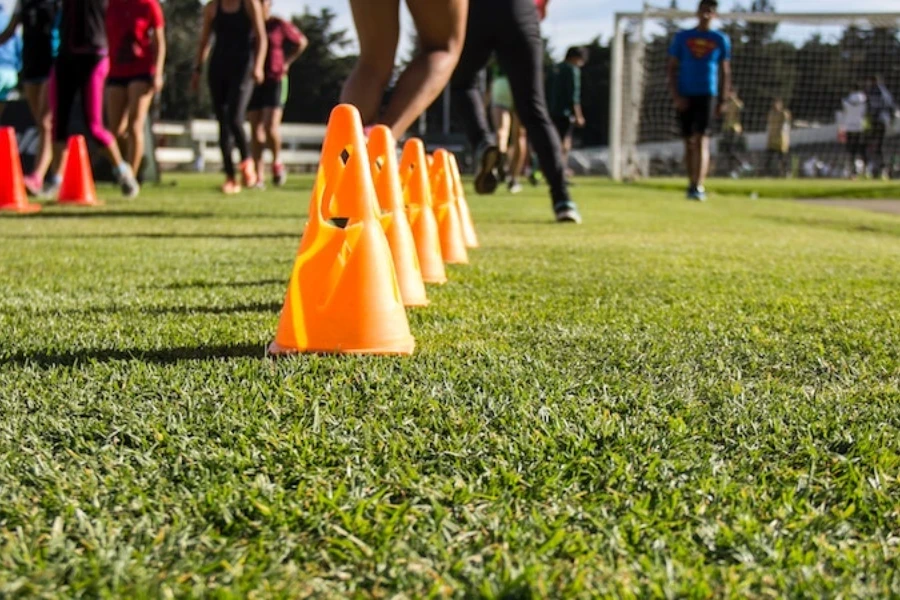
While they aren’t essential gear, players who want to hone their dribbling skills, agility, and tactical understanding of soccer might find cones helpful during training sessions.
Fitness trackers
Professional soccer players must maintain excellent fitness levels to achieve optimal performance. Fitness trackers can allow players to monitor their fitness levels by measuring blood oxygen levels, heart rate, distance covered, calories burnt, and sleep quality. Look for water-resistant fitness trackers that offer excellent battery life to meet the needs of football players.
Speed ladders
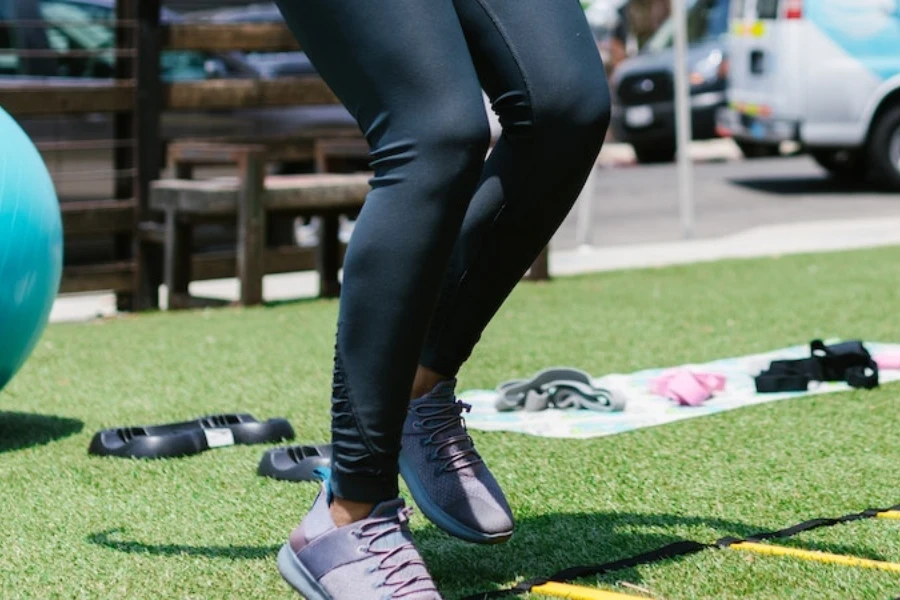
Speed or agility ladders are long, ladder-like structures made of nylon or plastic. They are usually placed flat on the ground and have evenly spaced rungs. Players use agility ladders during training to improve footwork, speed, agility, and coordination.
Soccer ball shooting machine
A soccer ball shooting machine, also known as a soccer ball launcher or pitching machine, automatically shoots soccer balls at various speeds, angles, and trajectories. It’s mainly used to enhance shooting, ball control, and goalkeeper handling skills, making it a valuable piece of equipment — especially for pro players.
For pro players and coaches who want to focus entirely on training drills and simulate realistic game scenarios, look for soccer ball machines with remote control support.
Find a wide selection of soccer training equipment
Soccer training equipment is essential for players who want to hone their skills, improve their performance or just enjoy the game. From soccer balls and shoes to cones and agility ladders, visit Alibaba.com to find a wide range of soccer gear.
